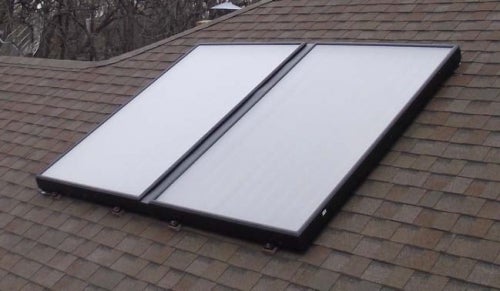If you would like to see more information on this case study, click here!
You can request this case study and a WCDE staff member will get back to you.
Dimplex North America Ltd., located in Cambridge, Ontario, is a leading heating products manufacturer. Dimplex recently expanded its portfolio from electric heating products to address the new renewable energy products market. One such product is Dimplex’s Solar Thermal Hot Water System (STHWS) used to heat potable water in a residential setting using energy from the sun, as opposed to gas or electricity. Large collectors, Figure 1, are used to absorb solar heat which is transferred to a circulating heat transfer fluid. As such, the collectors sit at temperatures between 125 to 150°C, which makes them ideal sources of energy for generating electricity using thermoelectric generators (TEGs).
TEGs generate electrical power when there is a temperature difference between the two sides of the solar collector. Ideally, implementation of TEGs should generate, at minimum, enough electricity to run the pumps required for a STHWS to circulate the heat transfer fluid. Dimplex wants to determine the feasibility of adapting the collectors of a STHWS to include TEGs. This involves the evaluation of specifications provided by TEG manufacturers to calculate the expected performance in a solar panel application. Roger Tsang, a third year Mechanical Engineering co-op student from the University of Waterloo, was asked to assess the feasibility of integrating TEG devices into STHWS applications.

Figure 1 - Flat plate solar panel collector
The teaching objective of this case is to illustrate properties and performance of thermoelectric generators for solar hot water heating applications. Topics in heat transfer, including power output, thermal conduction (Fourier’s Law), thermoelectric effect (“Seebeck effect”), efficiency, and figure of merit are covered in the case study and modules.
If you would like to see more information on this case study, click here!
You can request this case study and a WCDE staff member will get back to you.
Contact Waterloo Cases in Design Engineering
Steve Lambert
Tel: (519) 888-4728
Email: steve@uwaterloo.ca
The University of Waterloo acknowledges that much of our work takes place on the traditional territory of the Neutral, Anishinaabeg and Haudenosaunee peoples. Our main campus is situated on the Haldimand Tract, the land granted to the Six Nations that includes six miles on each side of the Grand River. Our active work toward reconciliation takes place across our campuses through research, learning, teaching, and community building, and is co-ordinated within the Office of Indigenous Relations.